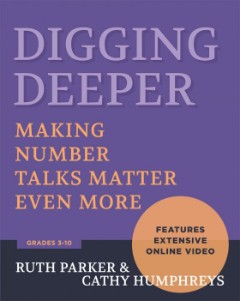Making Number Talks Matter Even More
Digging Deeper: Making Number Talks Matter Even More (Grades 3-10)
By Ruth Parker and Cathy Humphreys
(Stenhouse, 2018 – Learn more)

Do you want to know about Number Talks – what they are, how to implement them, and if they are worth it? Do you already use Number Talks and want a few tips and insights to make them even more beneficial?
Are you a math teacher for any grade 3-10 and want to improve student foundational understandings of Number Sense? Digging Deeper: Making Number Talks Matter Even More (Grades 3-10) will help you.

Used effectively, Number Talks can produce many desirable results: students build self-confidence, expand their appreciation for math studies, and gain working expertise with flexible strategies rather than just fixed rules.
A resource-packed sequel
Ruth Parker and Cathy Humphreys have written a sequel to “Making Number Talks Matter” that (as the title suggests) “goes deeper” by including numerous examples of dialogue among real students with honest responses.
Chapter titles include “Mistakes,” “Revising the Number Talk Routine: Rethinking Wait Time,” “The Questions We Ask: What? Why? When?,” “Helping Students Have Their Own Mathematical Ideas,” “Dot Talks,” “Safety,” and More “Bumps in the Road.”
First, the authors provide written descriptions and explanations of these talks. Second, they include extensive online video links (via URLs and QR codes) of actual non-rehearsed classroom Number Talks. I found these videos highly valuable and worth the investment even if nothing else had been included.
But they do include more. Third, Dot Talk masters are included. Dot Talks are sort of a prequel or starting point for Number Talks. Fourth, a step-by-step procedure is provided (especially helpful for those who have not yet engaged in classroom Number Talks). Fifth and finally, Parker and Humphreys include tips for when things don’t go exactly as planned.
I really appreciated the honesty of the authors. They concede that they do not have all the answers They admit that they continue to make mistakes. Through the included videos, they demonstrate that they are continually learning how to better successfully engage students with meaningful math dialogue.
Rethinking practices
Just about every chapter provided a take-away for me. One specific idea I am still chewing on is re-thinking wait-time. Teachers (myself certainly included) are sometimes fearful of silence. When responses do not come quickly, I tend to fill the void with an additional “clue” or maybe a restatement of the question or calling on students who have not volunteered (unthinkable). Parker and Humphreys encourage us to re-think wait time and provide several reasons and positive results from doing so.
The chapter “Safety” is an excellent addition. It mentions some commonly accepted practices for having students share verbally in class (popsicle sticks, turn and share, and me-too signals). The authors suggest these may need to be reconsidered for some math classes and share examples showing that these practices may actually be decreasing student engagement in classrooms.
I have never included formal Number Talks in my regular instruction. But after reading this book, I am excited and cannot wait to begin adding Number Talks this coming academic year.
Michael Hernandez is an eighth grade Math and Algebra teacher near Akron, Ohio. He has served on the Ohio Math Model Curricula and Content Advisory Committees. He began his career working with Middle School, High School and College students. Through the years, he was “promoted” to the point where his time was spent mostly with adults. Now he is back with the young people he loves where he has been teaching for 10 years.






























